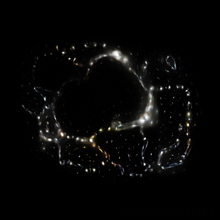KBC Void
The KBC Void (or Local Hole) is an immense, comparatively empty region of space, named after astronomers Ryan Keenan, Amy Barger, and Lennox Cowie, who studied it in 2013.[1] The existence of a local under-density has been the subject of many pieces of literature and research articles, the kind of which were penned starting in the early 90s.[2][3]

The under-density is proposed to be roughly spherical, approximately 2 billion light-years (600 megaparsecs, Mpc) in diameter. As other voids, it is not completely empty but contains the Milky Way, the Local Group, and a larger part of the Laniakea Supercluster. The Milky Way is within a few hundred million light-years of the void's centre.[4]
The existence of supervoids have been shown to be consistent with the standard cosmological model.[5] Galaxies inside a void experience a gravitational pull from outside the void and this yields a larger local value for the Hubble constant, a cosmological measure of how fast the universe expands. Some authors have proposed the structure as the cause of the discrepancy between measurements of the Hubble constant using galactic supernovae and Cepheid variables (72–75 km/s/Mpc) and from the cosmic microwave background and baryon acoustic oscillation data (67–68 km/s/Mpc).[6] However, other work has found no evidence for this in observations, finding the scale of the claimed under-density to be incompatible with observations which extend beyond its radius.[7]
See also
References
- Keenan, Ryan C.; Barger, Amy J.; Cowie, Lennox L. (2013). "Evidence for a ~300 Mpc Scale Under-density in the Local Galaxy Distribution". The Astrophysical Journal. 775 (1): 62. arXiv:1304.2884. Bibcode:2013ApJ...775...62K. doi:10.1088/0004-637X/775/1/62. S2CID 118433293.
- Busswell, G. S.; Shanks, T.; W. J. Frith, P. J. O.; Metcalfe, N.; Fong, R. (2004-11-11). "The local hole in the galaxy distribution: new optical evidence". Monthly Notices of the Royal Astronomical Society. 354 (4): 991–1004. arXiv:astro-ph/0302330. Bibcode:2004MNRAS.354..991B. doi:10.1111/j.1365-2966.2004.08217.x. ISSN 0035-8711. S2CID 18260737.
- Frith, W. J.; Busswell, G. S.; Fong, R.; Metcalfe, N.; Shanks, T. (November 2003). "The local hole in the galaxy distribution: evidence from 2MASS". Monthly Notices of the Royal Astronomical Society. 345 (3): 1049–1056. arXiv:astro-ph/0302331. Bibcode:2003MNRAS.345.1049F. doi:10.1046/j.1365-8711.2003.07027.x. S2CID 2115068.
- Siegel, Ethan. "We're Way Below Average! Astronomers Say Milky Way Resides In A Great Cosmic Void". Forbes. Retrieved 2017-06-09.
- Sahlén, Martin; Zubeldía, Íñigo; Silk, Joseph (2016). "Cluster–Void Degeneracy Breaking: Dark Energy, Planck, and the Largest Cluster and Void". The Astrophysical Journal Letters. 820 (1): L7. arXiv:1511.04075. Bibcode:2016ApJ...820L...7S. doi:10.3847/2041-8205/820/1/L7. ISSN 2041-8205. S2CID 119286482.
- Shanks, T; Hogarth, L M; Metcalfe, N (2019-03-21). "Gaia Cepheid parallaxes and 'Local Hole' relieve H 0 tension". Monthly Notices of the Royal Astronomical Society: Letters. 484 (1): L64–L68. arXiv:1810.02595. Bibcode:2019MNRAS.484L..64S. doi:10.1093/mnrasl/sly239. ISSN 1745-3925.
- Kenworthy, W. D’Arcy; Scolnic, Dan; Riess, Adam (2019-04-24). "The Local Perspective on the Hubble Tension: Local Structure Does Not Impact Measurement of the Hubble Constant". The Astrophysical Journal. 875 (2): 145. arXiv:1901.08681. Bibcode:2019ApJ...875..145K. doi:10.3847/1538-4357/ab0ebf. ISSN 1538-4357. S2CID 119095484.
Further reading
- Hoscheit, Benjamin L.; Barger, Amy J. (2018-02-09). "The KBC Void: Consistency with Supernovae Type Ia and the Kinematic SZ Effect in a ΛLTB Model". The Astrophysical Journal. 854 (1): 46. arXiv:1801.01890. Bibcode:2018ApJ...854...46H. doi:10.3847/1538-4357/aaa59b. S2CID 119220508.